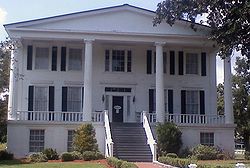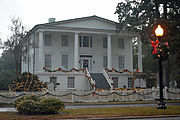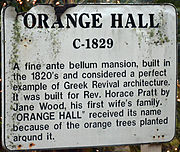
|
|
|
|
|
|
Orange Hall
|
|
|
| |
|---|
| / 30.72431; -81. |
|---|
| |
|---|
| |
|---|
| |
|---|
| |
|---|
| |
|---|
Orange Hall c. 1830, is located at 311 Osborne St.,
St. Marys, Georgia,
United States, located within the
St. Marys Historic District in
Camden County and was listed on the
National Register of Historic Places on May 7, 1973. In 2011, Orange Hall was added to the list of the state of Georgia's ten most endangered historic sites by the Georgia Trust for Historic Preservation.
A good example of the temple-form Greek Revival dwelling. It has been said that Orange Hall was the first example of Greek Revival design in America. There is no more shining example of this style, so favored in the Antebellum South, than Orange Hall. The name originated from the orange trees that surrounded the house. She reigns in a grandeur as you make your entrance into the historic district of St. Marys. Worthy of magazine covers and movie sets, Orange Hall holds a special place in the hearts of all St. Mary' citizens and is a beacon to history buffs who appreciate the grand beauty of this era. It is a frame building with clapboard siding. Other details include: two stories, gabled roof, interior chimneys, front center entrance with side lights and transom surmounted by low pedimented lintel, front tetrastyle prostyle Doric pedimented portico supported by projecting basement, rear center recessed 2-story porch.
Historic American Buildings Survey
The Library of Congress, Historic American Buildings Survey/Historic American Engineering Record has the following data recorded regarding Orange Hall. Owner in 1934: S.C. Townsend, Date of Erection: 1810-1815, Architect: No record, Builder: No record, Built for the Rev. Horace Southworth Pratt, a Presbyterian minister.
Architectural notes
This building of the Early Republican period is a Doric prostyle temple. The pediment is flattened and the columns are widely spaced. At the rear end is a superimposed inset portico, one porch above the other.
The brink basement storey is stuccoed and has stucco quoins of inch projection. In the basement used to be the old kitchen, now marked by its whitewashed walls, a herringbone brick floor pattern and a Dutch oven. The old Dining Room was under the front portico.
| Orange Hall |
|---|
|
|
Decorated for the holidays
|
|













No comments:
Post a Comment